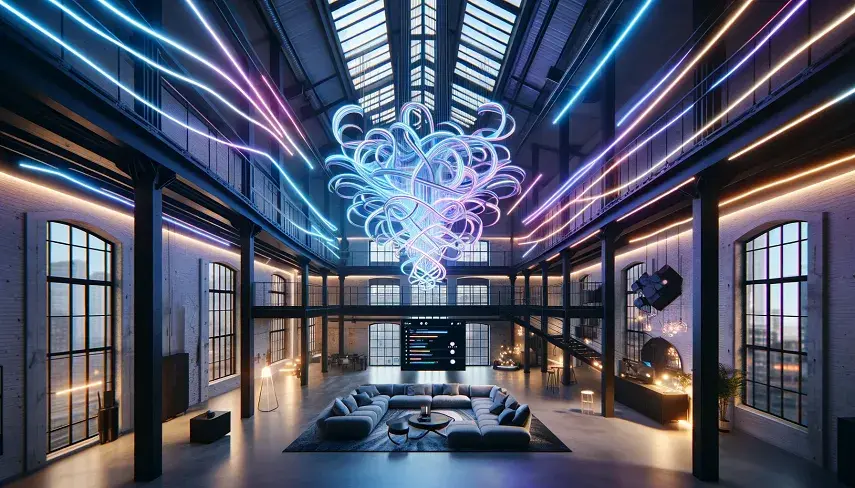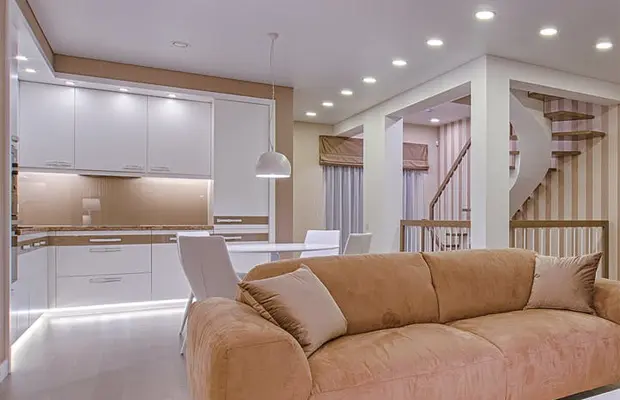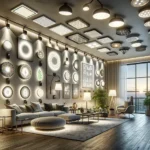LED lights are now the top choice for homes and offices. They save money and last longer than old bulbs. Many people switch to LED fixtures every day. This guide helps you learn about LED lights and why they work better.
What Are LED Lights and How Do They Work

LED stands for Light Emitting Diode. These lights work different from old bulbs. They don’t heat up metal wires to make light. Instead, they use special chips that turn electricity into light.
LED lights have these main parts:
- Small chip: Makes the light when electricity flows through it
- Metal piece: Keeps the chip cool so it lasts longer
- Power control: Makes sure the right amount of electricity goes to the chip
- Clear cover: Spreads the light where you need it
- Outside case: Protects all the parts inside
LED lights stay cool when they work. This makes them safe to touch. You can control how bright they are. You can also change their color in some types.
Types of LED Light Fixtures You Can Buy
LED lights come in many shapes and sizes. Each type works best for different rooms and jobs. Here are the most common types you can find:
LED Lights for Inside Your Home

Your home needs different kinds of lights for different rooms:
- Ceiling lights: These fit flat into your ceiling and light the whole room
- Track lights: You can move these lights to point where you want
- Hanging lights: These hang down from the ceiling over tables and counters
- Fancy lights: Beautiful lights that make your room look nice and give good light
- Under cabinet lights: Long thin lights that go under kitchen cabinets
- Flat panel lights: Square or rectangle lights that give even light all over
- Strip lights: Flexible lights you can bend around corners and curves
- Table lamps: Lights you can move around and put on desks or tables
LED Lights for Outside Your Home
Outside lights need to handle rain, snow, and hot sun:
- Flood lights: Very bright lights for yards and driveways
- Path lights: Small lights that show walkways and gardens
- Wall lights: Lights that attach to your house walls
- Street lights: Big lights for parking lots and roads
- Solar lights: Lights that charge from the sun during the day
- Pool lights: Waterproof lights that work underwater
Special LED Lights for Specific Jobs
Some places need special kinds of LED lights:
- Emergency lights: Lights that work when the power goes out
- Plant grow lights: Special colored lights that help plants grow
- Hospital lights: Very bright lights that show true colors
- Factory lights: Strong lights that work in tough places
Main Benefits of LED Light Fixtures
This comprehensive guide to LED light fixtures and their advantages shows why LED lights beat old bulbs in every way.
They Use Less Power and Save Money
LED lights use much less electricity than old bulbs:
- Lower electric bills: Your monthly power bill goes down right away
- Use 80% less power: LED lights need only 20% of the power old bulbs use
- Pay for themselves: The money you save pays for the new lights in 2-3 years
- Get rebates: Power companies give money back when you buy LED lights
- Less stress on wires: Your home electrical system works easier
They Last Much Longer
LED lights work for many more years than old bulbs:
- Work for 25 years: Good LED lights can work for 50,000 hours
- Don’t burn out suddenly: They get dimmer slowly over time instead of dying fast
- Handle bumps: They don’t break as easy as glass bulbs
- Work in hot and cold: Temperature changes don’t hurt them
- Save time: You don’t need to change bulbs as often
They Give Better Light
LED lights make better quality light than old bulbs:
- Turn on instantly: No waiting for them to warm up
- Same color always: The light color stays the same for years
- Show true colors: Things look their real colors under LED light
- Work with dimmers: You can make them brighter or dimmer
- Point where needed: The light goes exactly where you want it
- Change colors: Some can make different colors when you want
They Help the Earth
LED lights are better for our planet:
- Use less power: Power plants make less pollution
- No bad chemicals: They don’t have mercury like some old bulbs
- Can be recycled: Most parts can be used again
- Less wasted light: They don’t light up the sky by mistake
- Make less heat: Your air conditioner doesn’t work as hard
How to Pick the Right LED Lights
Choosing good LED lights means thinking about what you need them to do.
How Much Light You Need
Different rooms need different amounts of light:
- Bright lights: Kitchens and work areas need lots of light
- Medium lights: Living rooms need comfortable light
- Soft lights: Bedrooms need gentle light for relaxing
- Check the lumens: Higher numbers mean brighter light
- Think about the room size: Big rooms need more light
What Color Light You Want
LED lights come in different colors:
- Warm yellow: Makes rooms feel cozy like old bulbs
- Pure white: Good for kitchens and bathrooms
- Cool white: Makes you feel awake and alert
- Daylight: Like sunlight for seeing colors right
Things to Check Before You Buy
Make sure the LED lights will work in your home:
- Right voltage: Check if they match your electrical system
- Work with dimmers: Make sure they dim if you have dimmer switches
- Fit the space: Check if they fit where you want to put them
- Stay cool: Make sure air can flow around them
- Work with controls: Check if they work with smart home systems
How to Install LED Lights the Right Way
Good installation makes LED lights work better and last longer.
Electrical Things to Know
LED lights need the right electrical setup:
- Right power supply: Make sure they get the right amount of electricity
- Safety switches: Install breakers to protect the lights
- Good ground wire: Connect ground wires for safety
- Right wire size: Use thick enough wires for the electricity needed
- Surge protection: Protect expensive LED lights from power spikes
Keeping Them Cool
LED lights need to stay cool to work well:
- Air flow: Make sure air can move around the lights
- Heat sinks: Check that cooling parts are big enough
- Room temperature: Think about how hot the room gets
- Space between lights: Don’t put them too close together
- Away from heat: Keep them away from hot things
When to Hire Someone vs Do It Yourself
Some LED lights you can install yourself. Others need an electrician:
- Simple changes: Screwing in new LED bulbs is easy to do yourself
- Hard jobs: Ceiling lights and outdoor lights often need help
- New wiring: Always hire an electrician for new electrical work
- Big projects: Large installations work better with professional help
- Keep warranty: Some companies require professional installation
Taking Care of Your LED Lights
LED lights need very little care. But some simple steps help them last longer.
Regular Care Tasks
Do these things to keep your LED lights working great:
- Clean them: Wipe dust off the lights and covers
- Check connections: Make sure wires are tight and clean
- Watch for problems: Look for lights that flicker or dim
- Clean heat parts: Remove dust from cooling fins
- Note changes: Write down when lights seem different
Fixing Common Problems
Know how to fix typical LED light issues:
- Lights flicker: Usually the dimmer switch doesn’t match the LED
- Lights die early: Often too much heat or bad quality parts
- Color changes: May mean the light is getting old or too hot
- Gets dimmer: Normal after many years or sign of problems
- Smart features don’t work: Check your wifi or control app
What’s Coming Next for LED Lights
LED lights keep getting better. New features make them even more useful.
Smart Light Features
New LED lights can connect to your phone and internet:
- Control from phone: Turn lights on and off from anywhere
- Motion sensors: Lights turn on when you enter the room
- Voice control: Tell Alexa or Google to change your lights
- Track power use: See how much electricity your lights use
- Set schedules: Lights turn on and off at set times
Better LED Technology
Scientists keep making LED lights better:
- Use even less power: New designs waste less electricity
- Better colors: Lights show colors more like real sunlight
- Change through the day: Lights can match natural light changes
- Smaller sizes: Tiny LED lights fit in new places
- Flexible lights: Thin flexible sheets that light up
Final Thoughts
This comprehensive guide to LED light fixtures and their advantages shows why LED lights are the best choice today. They save money on electric bills and last for many years. LED lights help the earth by using less power and have no dangerous chemicals. Whether changing one bulb or lighting your whole house, LED lights give you the best value. The money you save on electricity pays for the lights quickly. LED lights are the future of lighting that saves money while improving your home.






